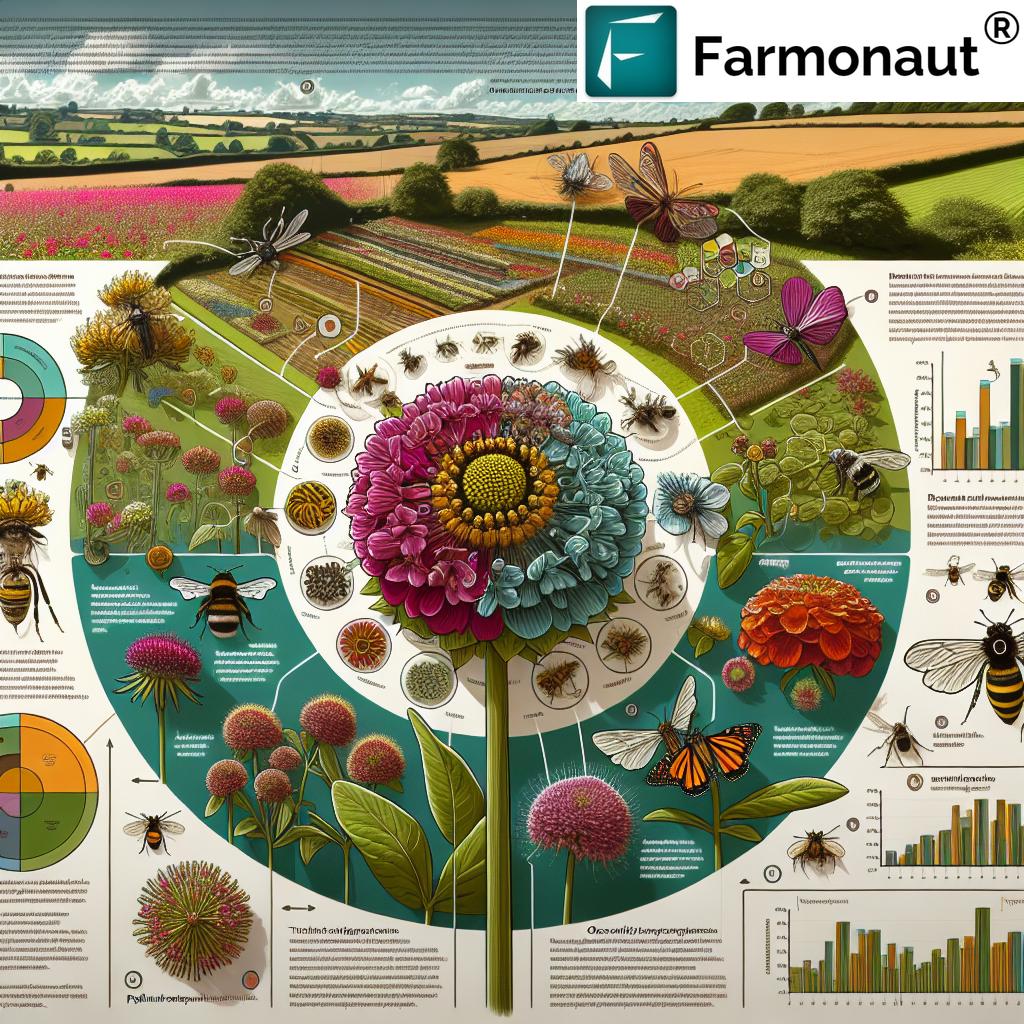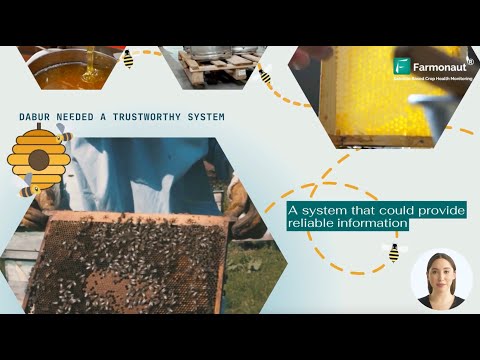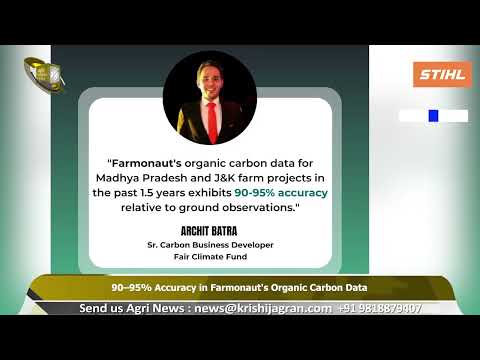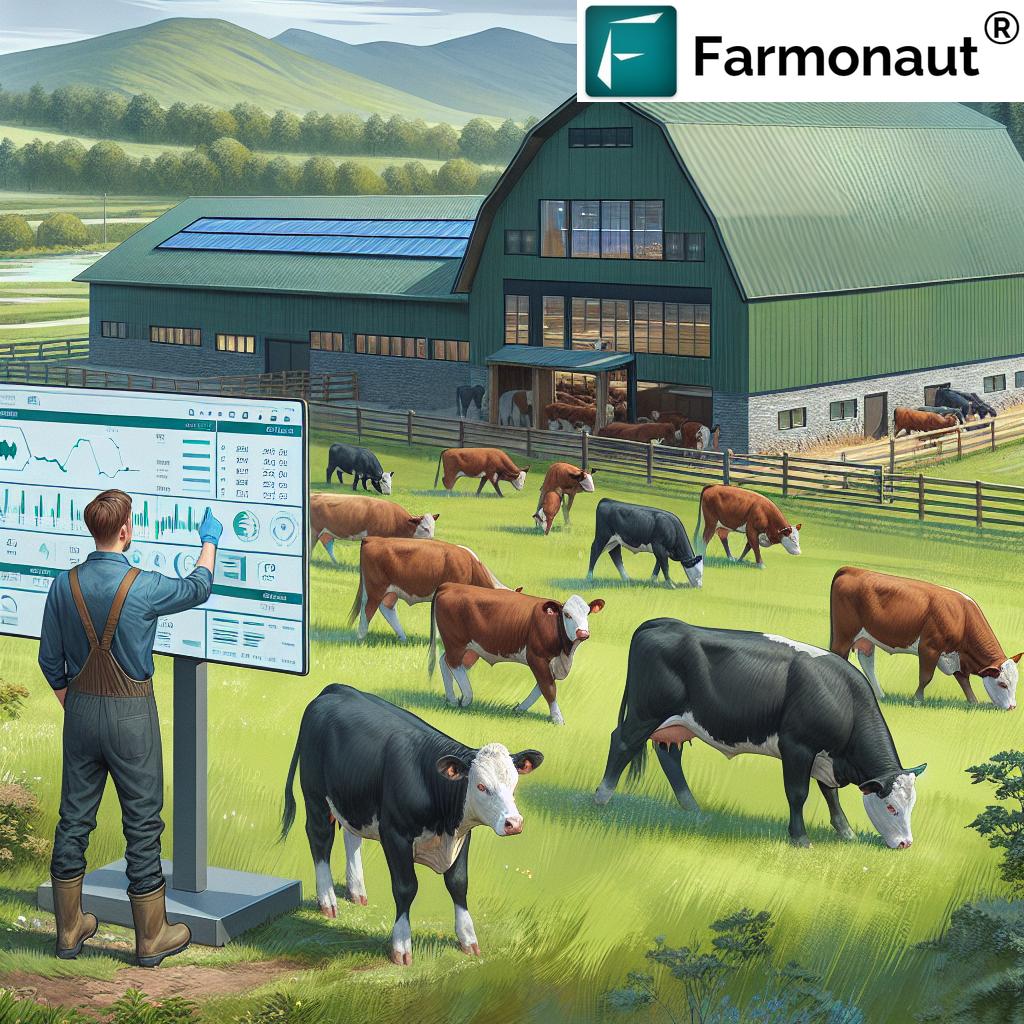Beyond Honeybees: Rethinking Pesticide Risk Assessments for Comprehensive Pollinator Protection in British Agriculture
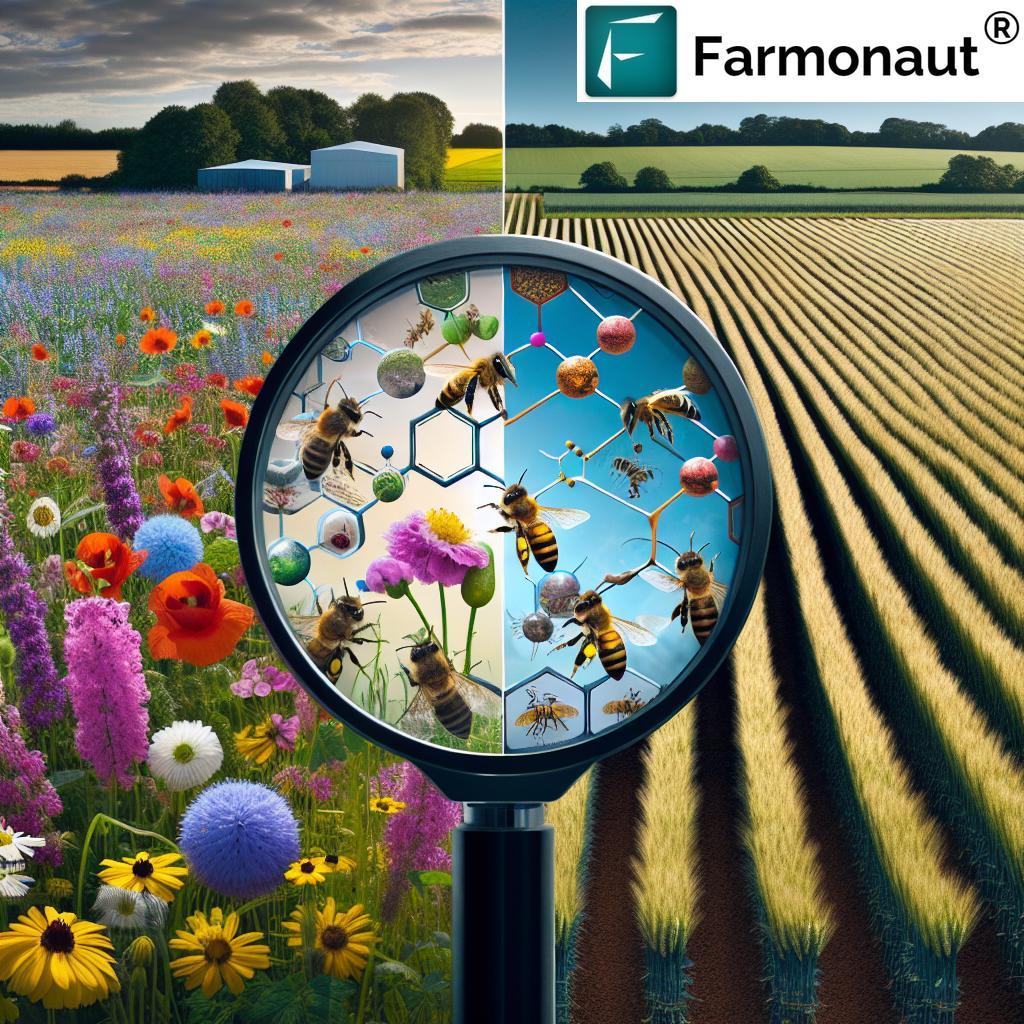
“Over 75% of global crops rely on animal pollination, with bees being the primary pollinators.”
In the verdant fields of British agriculture, a quiet revolution is taking place. As we stand at the crossroads of sustainable farming practices and the pressing need for pollinator protection, we find ourselves reevaluating long-held assumptions about pesticide risk assessments. The buzz around honeybees has long dominated our approach to agricultural ecosystem health, but it’s time we broadened our perspective to encompass the rich tapestry of pollinators that sustain our crops and natural landscapes.
At Farmonaut, we’re committed to leveraging cutting-edge technology to support sustainable agriculture. While we don’t directly conduct pesticide assessments, our satellite-based crop health monitoring and AI-driven advisory systems can help farmers make informed decisions about pest management, potentially reducing the need for chemical interventions.
The Current Landscape: Honeybee-Centric Assessments
For decades, the humble honeybee has been the poster child for pollinator protection in agriculture. Its importance cannot be overstated – these industrious insects play a crucial role in pollinating a wide variety of crops, from apples in Kent to oilseed rape in Yorkshire. However, the singular focus on honeybees in pesticide risk assessments may be leaving gaps in our understanding of how these chemicals affect the broader pollinator community.
- Honeybees are just one species among thousands of pollinators
- Different pollinators have varied sensitivities to pesticides
- Diverse habitats and foraging behaviors affect pesticide exposure
The current regulatory frameworks for pesticide use in British agriculture primarily revolve around honeybee safety. While this approach has undoubtedly contributed to protecting these vital insects, it may not provide a comprehensive shield for the myriad other pollinators that contribute to our agricultural success and biodiversity.
Expanding the Scope: Why We Need a More Inclusive Approach
As we delve deeper into the intricate web of pollination ecology, it becomes clear that a one-size-fits-all approach to pesticide risk assessment is insufficient. The British countryside is home to a diverse array of pollinators, each playing a unique role in maintaining the health of our ecosystems and the productivity of our farms.
“Pesticide risk assessments focused solely on honeybees may overlook up to 90% of wild pollinator species.”
This staggering statistic underscores the urgency of rethinking our approach. From the industrious bumblebees buzzing through our vegetable patches to the delicate hoverflies pollinating our orchards, each species interacts with pesticides in different ways. By broadening our assessments, we can ensure that our crop protection strategies safeguard not just honeybees, but the entire spectrum of pollinators that support British agriculture.
The Impact on British Farms and Rural Landscapes
The implications of a more comprehensive pesticide risk assessment extend far beyond the laboratory. For British farmers, this shift could mean adapting their pest management strategies to protect a wider range of beneficial insects. It’s a challenge, but also an opportunity to enhance the resilience and sustainability of our agricultural systems.
- Diversified pollinator populations can improve crop yields
- Enhanced biodiversity supports natural pest control
- Sustainable practices can lead to long-term farm productivity
At Farmonaut, we understand the importance of balancing crop protection with environmental stewardship. Our satellite-based crop health monitoring can help farmers identify pest issues early, potentially reducing the need for broad-spectrum pesticide applications. By integrating this technology with a more nuanced understanding of pollinator protection, we can work towards a future where British farms thrive alongside healthy pollinator populations.
Explore our crop monitoring solutions: Farmonaut Web App

Integrated Pest Management: A Cornerstone of Pollinator-Friendly Farming
As we reassess our approach to pesticide risk, integrated pest management (IPM) emerges as a crucial strategy for British farmers. This holistic approach combines biological, cultural, physical, and chemical tools to manage pests while minimizing risks to pollinators and the environment.
- Crop rotation to disrupt pest life cycles
- Encouragement of natural predators
- Use of resistant plant varieties
- Targeted pesticide application when necessary
By adopting IPM strategies, farmers can reduce their reliance on chemical pesticides, creating a more hospitable environment for diverse pollinator species. This approach aligns perfectly with the principles of sustainable agriculture and the growing consumer demand for environmentally friendly produce.
The Role of Technology in Pollinator Protection
In the digital age, technology plays an increasingly important role in agricultural decision-making. At Farmonaut, we’re at the forefront of this revolution, offering tools that can significantly contribute to pollinator protection efforts.
- Satellite imagery for precise crop monitoring
- AI-driven advisory systems for optimized pest management
- Weather forecasting to guide pesticide application timing
By leveraging these technologies, farmers can make more informed decisions about when and where to apply pesticides, potentially reducing overall usage and minimizing impact on pollinators. Our Jeevn AI system, for instance, provides personalized recommendations that take into account various factors affecting crop health, helping farmers strike the right balance between pest control and pollinator protection.
Discover our AI-powered farming solutions: Farmonaut Android App | Farmonaut iOS App


Rethinking Regulatory Frameworks
As we advocate for a more comprehensive approach to pesticide risk assessment, it’s crucial to consider how this shift might impact regulatory frameworks in British agriculture. The current system, while effective in many ways, may need to evolve to encompass the protection of a broader range of pollinators.
- Expanding test species beyond honeybees
- Considering varied exposure routes for different pollinators
- Assessing long-term and sublethal effects
- Incorporating field studies in diverse agricultural landscapes
By refining our regulatory approach, we can ensure that pesticide risk assessments provide a more accurate picture of potential impacts on the entire pollinator community. This, in turn, can lead to more effective and targeted pest management strategies that protect both crops and beneficial insects.
The Economic Case for Comprehensive Pollinator Protection
While the environmental benefits of protecting diverse pollinator species are clear, there’s also a compelling economic argument for this approach. British agriculture relies heavily on pollination services, with many high-value crops dependent on insect pollination.
- Increased crop yields through diverse pollination
- Reduced costs associated with managed honeybee colonies
- Potential for premium pricing on pollinator-friendly produce
- Long-term sustainability of agricultural ecosystems
By investing in comprehensive pollinator protection, we’re not just safeguarding biodiversity – we’re securing the future of British farming. At Farmonaut, we’re committed to supporting farmers in this transition through our innovative technology solutions.
Comparative Analysis: Current vs. Comprehensive Assessment Methods
To better understand the potential impact of a more inclusive approach to pesticide risk assessment, let’s examine a comparative analysis of current honeybee-centric methods versus a comprehensive pollinator approach:
| Assessment Criteria | Honeybee-Centric Method | Comprehensive Pollinator Method | Impact on Agricultural Ecosystem |
|---|---|---|---|
| Species Diversity Considered | Limited (primarily honeybees) | Extensive (multiple pollinator species) | Higher biodiversity, improved ecosystem resilience |
| Exposure Routes Evaluated | Focused on honeybee-specific routes | Diverse routes for various pollinators | More accurate risk assessment, better targeted mitigation |
| Long-Term Effects Assessment | Limited consideration | Comprehensive evaluation of chronic effects | Enhanced long-term sustainability of pollinator populations |
| Integration with IPM Strategies | Partial integration | Fully integrated approach | Reduced pesticide dependence, improved natural pest control |
| Regulatory Framework Alignment | Well-established but narrow focus | Evolving to encompass broader impacts | More holistic protection of agricultural ecosystems |
This comparison highlights the potential benefits of adopting a more comprehensive approach to pesticide risk assessment. By considering a wider range of pollinator species and their varied interactions with agricultural environments, we can develop more effective and sustainable pest management strategies.
Case Study: Pollinator-Friendly Farming in Action
To illustrate the practical application of comprehensive pollinator protection, let’s consider a hypothetical case study of a British arable farm implementing these principles:
Greenfields Farm, a 200-hectare mixed arable operation in East Anglia, decided to transition to more pollinator-friendly practices. They implemented the following changes:
- Established wildflower margins around fields to provide diverse habitats
- Adopted a varied crop rotation including pollinator-friendly crops like oilseed rape and field beans
- Implemented IPM strategies, reducing overall pesticide use by 30%
- Used Farmonaut’s satellite monitoring to target pest hotspots, minimizing broad-spectrum applications
The results after three years were impressive:
- 20% increase in wild pollinator abundance and diversity
- 15% improvement in crop yields for insect-pollinated crops
- Reduced costs associated with pesticide purchases and application
- Improved soil health and reduced erosion due to increased ground cover
This case study demonstrates that by taking a holistic approach to pollinator protection, farms can not only contribute to biodiversity conservation but also improve their economic performance.
The Road Ahead: Challenges and Opportunities
As we advocate for a more comprehensive approach to pesticide risk assessment and pollinator protection in British agriculture, it’s important to acknowledge the challenges that lie ahead:
- Developing standardized testing protocols for diverse pollinator species
- Balancing the need for effective pest control with pollinator protection
- Educating farmers and stakeholders about the importance of diverse pollinators
- Adapting regulatory frameworks to incorporate new assessment methods
However, with these challenges come significant opportunities:
- Innovation in pest management technologies and practices
- Enhanced ecosystem services through increased biodiversity
- Potential for new market opportunities in pollinator-friendly produce
- Improved long-term sustainability of British agriculture
At Farmonaut, we’re excited to be part of this journey towards more sustainable and pollinator-friendly farming practices. Our technology solutions can play a crucial role in helping farmers navigate this transition, providing the data and insights needed to make informed decisions about pest management and crop health.
Explore our API solutions for agricultural data: Farmonaut API | API Developer Docs
Conclusion: A Call to Action for British Agriculture
As we conclude our exploration of pesticide risk assessments and pollinator protection in British agriculture, it’s clear that a paradigm shift is not just desirable – it’s essential. By moving beyond a honeybee-centric approach and embracing a more comprehensive view of pollinator protection, we can create a more resilient, sustainable, and productive agricultural system.
This transition will require collaboration across the entire agricultural sector – from farmers and researchers to policymakers and technology providers. At Farmonaut, we’re committed to supporting this evolution through our innovative satellite monitoring and AI-driven advisory systems, helping farmers make more informed decisions that benefit both their crops and the wider ecosystem.
As we look to the future of British farming, let’s embrace the challenge of protecting our diverse pollinator populations. By doing so, we’re not just safeguarding biodiversity – we’re investing in the long-term health and productivity of our agricultural landscapes. Together, we can create a future where bountiful harvests and buzzing fields of pollinators go hand in hand, ensuring a sustainable and prosperous future for British agriculture.
FAQs
- Why is it important to consider pollinators beyond honeybees in pesticide risk assessments?
Considering diverse pollinators ensures a more comprehensive protection of agricultural ecosystems, as different species have varied sensitivities to pesticides and play unique roles in pollination. - How can farmers implement more pollinator-friendly practices?
Farmers can adopt integrated pest management strategies, create diverse habitats, use targeted pesticide applications, and leverage technology for precise crop monitoring. - What role does technology play in pollinator protection?
Technology like Farmonaut’s satellite monitoring and AI advisory systems can help farmers make informed decisions about pest management, potentially reducing overall pesticide use. - How might regulatory frameworks need to change to accommodate a more comprehensive approach?
Regulatory frameworks may need to expand to include testing on multiple pollinator species, consider varied exposure routes, and assess long-term and sublethal effects of pesticides. - What are the economic benefits of protecting diverse pollinator species?
Economic benefits include increased crop yields through diverse pollination, reduced costs associated with managed honeybee colonies, and potential premium pricing for pollinator-friendly produce.
